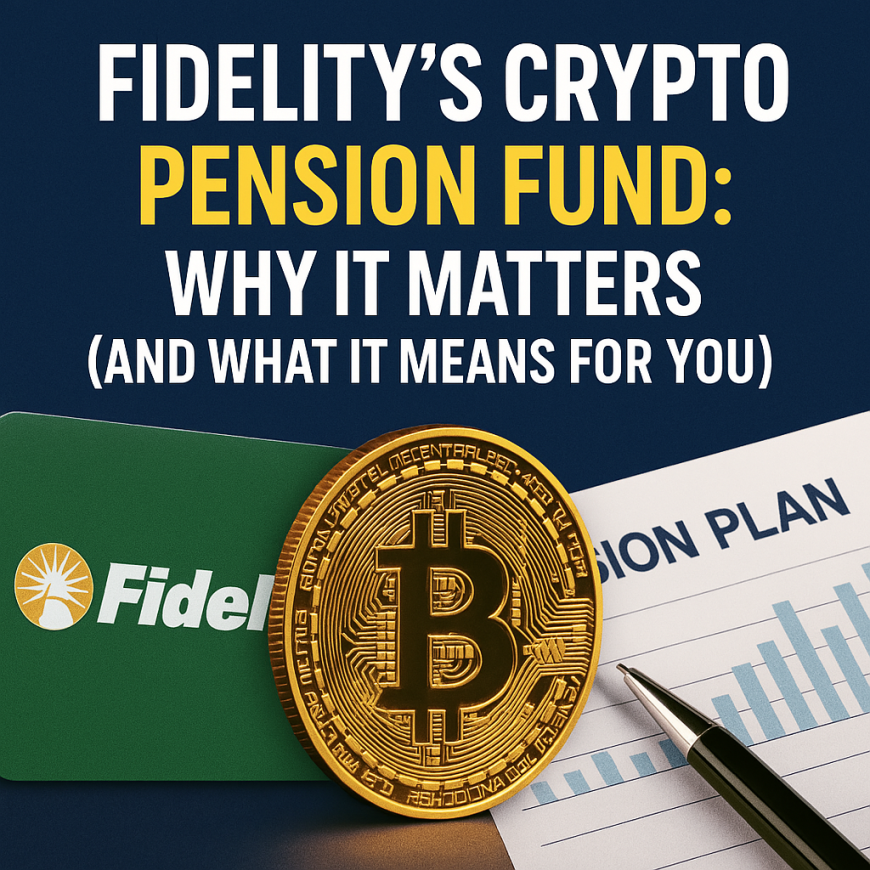Fidelity's Crypto Pension Fund: Why It Matters (And What It Means for You)
Fidelity is letting Americans invest in Bitcoin through their retirement plans. Here's why it matters: what the risks are and how beginners can think smartly about them. A must-read for crypto newcomers.

Crypto in a Pension Fund? Seriously?
Imagine this:
You’re thinking about your future. Retirement. Passive income.
And suddenly, one of the world’s biggest financial giants—Fidelity—says:
“We’re adding crypto to our pension plans.”
Wait... what?
Yes, it’s real.
Fidelity Investments, managing over $11 trillion in assets, announced it would let retirement savers allocate part of their 401(k) pension plans into Bitcoin.
To some, it sounds bold. To others, crazy. But to those of us already in the crypto space, it sounds like validation.
In this post, we’ll break down:
- What Fidelity’s crypto pension move actually means
- Why it’s such a big deal
- Whether it's safe
- And what beginners need to understand before jumping in
What Is Fidelity’s Crypto Pension Fund?
Fidelity is the first major retirement provider in the U.S. to offer Bitcoin as an option for 401(k) plans—the most common type of employer-sponsored retirement account.
Here’s how it works:
- Employees can allocate up to 20% of their 401(k) savings into Bitcoin
- The Bitcoin is held securely by Fidelity’s digital asset platform
- Employers have to opt in to allow it in their 401(k) plans
So, no, you won’t wake up one day to find your retirement account replaced with crypto.
But if your company chooses to offer it, you get to decide if you want exposure to Bitcoin.
Why This Is a Huge Deal
This is more than just a financial product. It’s a signal.
For years, crypto was called:
- A scam
- A bubble
- Internet funny money
Now?
One of the oldest, most conservative institutions in finance is saying:
"We believe Bitcoin has a long-term place in people’s retirement strategies."
That’s huge.
This does two things:
- Legitimizes crypto in traditional finance circles
- Bridges the gap between old money and new money
When Fidelity moves, Wall Street watches.
When pensions get involved, it’s not about hype.
It’s about long-term belief.
Why Would Anyone Put Crypto in a Retirement Fund?
Good question. Let’s look at the reasons behind the move:
1. Growth Potential
Bitcoin has outperformed every traditional asset over the last decade.
Yes, it’s volatile. But long-term? It’s been incredibly rewarding for early believers.
2. Hedge Against Inflation
Unlike the dollar, Bitcoin has a fixed supply (21 million max). That’s appealing when governments are printing money like there’s no tomorrow.
3. Diversification
Adding a small amount of crypto can help balance a portfolio, especially if it behaves differently than stocks and bonds during market swings.
But… Isn’t It Risky?
Yes. Crypto is high-risk—especially compared to traditional retirement investments like mutual funds or index funds.
Here’s what beginners need to understand:
✅ The Pros:
- Massive upside potential
- Early adoption advantages
- Opportunity to diversify beyond traditional assets
⚠️ The Cons:
- Volatility: Prices can swing 20% in a day
- Regulatory uncertainty: Governments may impose restrictions
- Emotional stress: It’s not easy watching your retirement drop 40% in a week
That’s why Fidelity limits it to 20% max per portfolio.
Even they know: this is not for your entire nest egg.
How to Think About This as a Beginner
If you're new to crypto, here’s how to mentally frame this:
Crypto in a pension fund is not about getting rich quick.
It’s about long-term exposure to an emerging asset class.
Most people build wealth slowly—through consistent investing over decades.
Adding Bitcoin into that mix (in small amounts) is like planting a seed in new soil.
Here’s how you might approach it:
- Treat it like venture capital: high risk, high-reward
- Keep it under 5-10% of your total retirement portfolio
- Use it to diversify, not dominate, your retirement strategy
- Stay in it for years, not months
What Does This Mean for the Crypto Space?
This move is a stamp of legitimacy.
If Bitcoin makes it into mainstream retirement accounts, here’s what could happen next:
- Other providers follow (Vanguard, Charles Schwab)
- Institutional adoption accelerates
- Regulation becomes clearer and more balanced
- Bitcoin becomes part of the “normal” financial world
In short, this opens the floodgates.
If millions of people can now buy crypto through their retirement accounts without even touching a crypto wallet or exchange…
That’s how mass adoption happens quietly.
Fidelity Isn’t New to Crypto
Let’s be clear: Fidelity didn’t just jump on a trend.
They’ve been in the crypto space since 2014, building infrastructure and doing deep research.
They:
- Have their own digital asset arm
- Provide custody services to institutional investors
- Support Bitcoin mining operations
- Were among the first to research Bitcoin’s long-term potential
They’re not just dipping a toe in. They’ve been building a diving board.
Should You Do It?
Golden rule: Never invest in something you don’t understand.
If you don’t understand how Bitcoin works, why it has value, or what makes it different from stocks, learn first.
Then decide:
- Does this align with your risk tolerance?
- Are you investing for the long term?
- Can you handle the emotional ride?
If yes, and if your employer offers it, allocating a small percentage could be a smart move—especially if you want exposure but don’t want the hassle of managing crypto yourself.
Final Thoughts: The Future of Finance Is Changing
Fidelity’s crypto pension offering is not just about Bitcoin.
It’s about the evolution of investing.
Traditional finance is waking up to digital assets.
Crypto is no longer just for traders, techies, or Twitter influencers.
It’s entering 401(k)s, portfolios, and pensions.
That’s a massive shift.
If you're just starting out, don’t panic. Don’t FOMO.
Instead, get curious. Get educated.
And remember: wealth is built patiently, not emotionally.
This might just be the beginning of something big.



